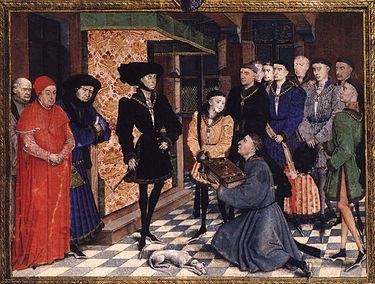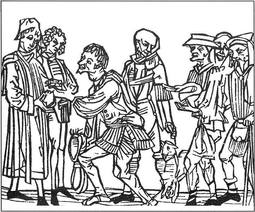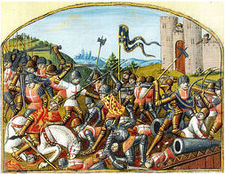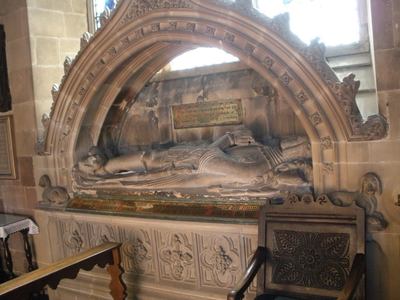Philip died in Bruges and was succeeded by his son Charles the Bold, who had married Margaret of York in 1468.
|
Philip the Good, the Duke of Burgundy died on the 5th June in 1467. Philip was a man who is said to have loved pomp and circumstance, he had many mistresses and three wives, he also had seventeen illegitimate children that he acknowledged as his. His court was a fun place to be it was full of jewel-adorned courtiers, there were banquets, dancing and music, there was jousting and tournaments. No wonder he was called the Philip the Good. Everybody seemed to have a whale of a time! On a serious note, he was a capable military leader. He allied himself with England in 1420 recognising Henry V as the future king of France, and it was Phillip who handed over Joan of Arc to the English ten years later. In 1435 he rescinded on the 1420 Treaty of Troyes by recognising Charles VII of France as king.
Philip died in Bruges and was succeeded by his son Charles the Bold, who had married Margaret of York in 1468.
0 Comments
24th June 1497: John Cabot reached North America. The first map to use the name America is known as the Waldseemuller Map, it was published in the April of 1507 by German cartographer Martin Waldseemuller in his Universalis Cosmographia. The image below is the first map to show America as a continent, this too was created by a German cartographer known as Sebastian Munster. His work, Cosmographia was published in the mid sixteenth century and taken from book five of his works. This proves that America was known to us in the time of Henry VIII. So who actually discovered America? Well, it was not Christopher Columbus in 1498 according to a number of historians. These scholars claim there are a number of others who may have discovered the country many years before. In 2008, Gavin Menzies, a British historian, claimed it was one Chinese Admiral named Zheng in the first part of the fifteenth century. Menzies claims it was Zhengs map of 1418, seen here, that Columbus used when he plotted his journey to the new continent decades after Zheng. Over forty years ago in 1966, English scholar, Alwyn Ruddock, discovered a letter, dated 1498 written to Columbus by an English merchant who was named John Day. In it, Day said that it was ‘considered certain’ that the North American mainland had been ‘found and discovered in the past’ by seamen from the port of Bristol. Italian explorer John Cabot had visited Bristol the previous year, 1497, and left from there to eventually find Newfoundland. It was probably Cabot that Day was suggesting to Columbus who had 'seen' America. Ruddock also owned more papers suggesting that America had been reached as early as 1470. There is no way to confirm these facts as Ruddock, for some unknown reason, ordered all of these papers to be destroyed at her death.
Cabot indeed may have been in Bristol as the letters suggested as he had found an English investor to fund his journey, he had also received a patent from Henry VII. Another group of people in the running for the discovery, are the Scandinavians. When Columbus finally arrived in America the were already people living there, these were the descendants of the Vikings who had landed there between 970 to as late as 1066, Columbus would not have known that so we can see why he is credited. By far the most interesting candidate is one Abu Raihan al-Biruni, who is being put forward as 'discovering' America without leaving his desk. Biruni was an Islamic scholar born in 973. He studied cartography, mathematics, astronomy, geography and geometry. He had worked out the latitude and longitude of his own town and began to collect similar co-ordinates for other places. Biruni used ancient Greek sources to compile data on hundreds of other places in world and then began adding calculations on other locations from all points of the compass. If this is fact, then it can be said that he, in theory, discovered America a short time before the Vikings actually set foot in the country. If any of these contenders for the title of the discovery of America are proven to be fact then Christopher Columbus can still be credited with being the first to initiate regular contact between the peoples of America and Europe. The summer solstice or Litha, meaning a stopping or standing still of the sun, by tradition has been attracting people to monuments such as Stonehenge and Avebury for thousands of years. Once gathered people are able to witness the sun rising and setting on the longest day of the year. The origins of the Cornish Obby Oss dates back to the Beltane festival which celebrates the coming of summer or the Celtic worship of horse deities. It has been suggested that it may be related to the tradition of the Grey Mare in South Wales. The Obby Oss is one of many ritual beasts and monsters found in English folk traditions, in addition to Padstow’s Obby Oss there was a tradition in West Penwith of a similar creature called Pengwyn and another named Penglas, meaning grey/blue head, which was probably a horse’s skull that is usually associated with other festive occasions such as the midsummer fire festival Golowan, celebrated in Penzance, which has quite recently been revived. There is mention of a Oss in the Cornish language play Beunans Meriasek, about the life of a saint from the Cornish town of Camborne and the Oss is a companion or follower.
It was on the 12/13th June in 1381 that over 100,000 peasants marched to London, headed by one Wat Tyler, in the hope that government and their king would listen to their grievances. Between the years 1348 and 1350 thousands of men, women and children had died due to what we now call the Black Death. Just over thirty years later in 1381, England had still not recovered, workers were few, jobs were many, the treasury was empty and in an effort to counter this taxation was increased. This new tax angered the poor, for they had come to enjoy their 'freedom' and to a certain extent they had gained the ability to control their own lives. In 1380, to rectify the situation, a poll tax to raise money to help England financial situation was introduced that would initially result in the nonpayment of taxes but escalate into violence and death. The seeds of this revolt were set just a month previous, you can read about that here
meanderingthroughtime.weebly.com/history-blog/john-bampton-and-the-events-of-may-1381 Soon after Hastings William the Conqueror was quick to realise the importance of securing the West Country, the first step in achieving this was to take Exeter, the fourth largest city in the country. Exeter was still controlled by the Godwin family. Harold’s son had fled to Ireland but his mother, Gytha, who still lived within the city walls, held out against the Norman forces during William’s return to Normandy, however on his return to England he made the city his first port of call. Exeter’s city walls withstood an eighteen month winter siege, many of the Norman soldiers succumbed to the cold, eventually though Exeter fell and Gytha escaped with her granddaughters to island of Flatholme in the Bristol Channel. There is no mention of Harold's son’s at the Siege of Exeter and it may well be that they were already in Ireland. Gytha’s stand at Exeter in 1068 wasn’t the last effort by the Godwin's to take back some control of their father's country. Inevitably though, Devon would submit to Norman control, but before that Harold’s sons would give the invaders a run for their money. On the 26th June 1069, in the lush green fields that look over the Taw estuary, Godwine and Edmund landed with an invading force in what could actually be a rematch of the Battle of Hastings. New evidence has recently come to light that this battle took place in the fields that lie in between the villages of Northam and Appledore. The Godwin’s forces arrived from Ireland on board sixty four longs ships given to them by the Irish king of Leinster. The defending army was made up of Normans, Breton's and English headed by Brian of Brittany who had fought with the Conqueror at Hasting. Following the battle it is thought that a total more than 3,000 men died in this clash. Brian of Brittany was rewarded with lands in Cornwall, however the fates of the sons Harold is not known.
In June 1553, Edward VI's Devise for the Succession was signed by one hundred and two members of the royal council, in it he named his cousin Lady Jane Grey as his heir, and disinherited his half sisters Mary and Elizabeth. In the chaos following Mary being proclaimed queen, the signatories stated that they were forced to sign the document by John Dudley, the Duke of Northumberland. According to Jehan de Scheyfye, imperial ambassador, Edward feared John Dudley, and with his uncle Edward Seymour, a gentler, less imposing character dead and in the ground for over a year, the young king was right to do so. Northumberland, as Jane's father in law and Jane's parents, Francis and Henry Grey, were the epitome of grasping, self serving nobles who were not afraid to use and abuse their offspring if it meant getting what they desired. In Northumberland's case his intention was to be chief puppeteer, with a wish to make England dance to his tune, and no better way to start than organising marriages, to the benefit of himself, to high ranking nobles within the royal court. Guildford, Catherine and Katherine were all married on the same day, the 25th May 1553. With Edward's illness beginning in the February and three dynastic marriages taking place less than a month before the king became ill, it's difficult to believe that Dudley's only concern was king and country. As the court watched the king's life slipping away, Northumberland was quick to realise that the plans for his families rise to greatness was heading for the grave along with his sickly king. It most certainly had not slipped Dudley's mind, that on Edward's death, the Grey family members were at the top of Edwards list of heirs. It was still possible that Francis Grey could give Suffolk a son, and that would be disastrous for Dudley, he knew that whoever was at England's helm it would be Henry Grey who would be pulling the strings. All Northumberland needed to do was to whisper in the kings ear that it was in 'countries' interest that he declare Jane Grey his heir and then sit back and watch as the plans for his new 'dynasty', plans that had been in the making since at least 1525, come to fruition. The question has to be asked if Northumberland was a schemer, it has been said he was 'morally bankrupt' and 'the subtlest intriguer in English history.' However, there are those who would argue that Dudley was the Tudor dynasty's saviour in a time of in fighting, religious upheaval and rebellion, and if this was the case then perhaps the Duke of Northumberland was the right man for the job, however Dudley had much to gain and for me, this counteracts everything else. It has been suggested that the change to the succession was Edward's own idea and his own doing, and that this boy wasn't a pawn in the machinations of his protectors at all, but an intelligent, if somewhat sober, young man. However, at this point in time he was weak and vulnerable, would a boy so sick, whose body was swollen and covered in ulcers, who was suffering from a high fever and in great pain from bedsores, be able think about such a change? After all he had already made his decision and drafted it to his satisfaction, excluding his sister on the grounds of religion and illegitimacy, important reasons to him. No, Northumberland saw an opportunity and he took it. Edward made the changes to the succession, altering 'L Janes heires masles' to L Jane AND her heires masles' as you can see in the text below. On the 21st June, the Devise for the Succession of King Edward VI was signed, and on Edward's death on the 6th July, Jane Grey became queen. Never crowned, she 'reigned' for just nine days. Jane's story is a tragic one, she along with her husband, Guildford Dudley were tried for treason in November 1553 and executed on the 12th of February 1554. Henry Grey was executed ten days later. In August, just two weeks following Mary's triumphant ride through the streets of London, John Dudley was one of the first to climb the steps of the scaffold. What doe's that tell you? The Battle of Castillon ended in a French victory, and it marked the end of the Hundred Years War - although a peace treaty was never signed. The English, who achieved several major victories during the course of the war lost all their possession in France except for Calais which was recaptured by the French in 1558.It was at this battle that John Talbot lost his life, Talbot is said to have been the best general Henry VI had. In Shakespeare's play, John Talbot is seen as the last of the medieval heroes, a daring soldier loyal to his king while most of the English nobles are fighting among themselves, he was said to be the best general Henry VI had. O, no; wherein Lord Talbot was o'erthrown:
The circumstance I'll tell you more at large. The tenth of August last this dreadful lord, Retiring from the siege of Orleans, Having full scarce six thousand in his troop. By three and twenty thousand of the French Was round encompassed and set upon…. More than three hours the fight continued; Where valiant Talbot above human thought Enacted wonders with his sword and lance: Hundreds he sent to hell, and none durst stand him; Here, there, and every where, enraged he flew: The French exclaim’d, the devil was in arms; All the whole army stood agazed on him: His soldiers spying his undaunted spirit A Talbot! a Talbot! cried out amain And rush’d into the bowels of the battle. Henry VI Part One: Act 1, Scene 1 John Wesley was born in the last two weeks of May 1703 in the village Epworth in Lincolnshire. Lincoln Collage Oxford writes: "After completing his BA, Wesley followed the traditions of his family by taking Holy Orders and was made a deacon in Christ Church Cathedral in September 1725. Three years later he was ordained. In 1726 a vacancy became available for a Fellowship at Lincoln College, which at that time was open only to those born in the diocese of Lincoln. Wesley's father had connections with Dr Morley, Rector of Lincoln College, and after being examined in Homer and Horace he was duly elected to a fellowship on March 25th. Samuel Wesley was very content that his son was to become one of the twelve fellows and wrote: "What will be my own fate before the summer is over, God knows, sed passi graviora, wherever I am, my Jack is a fellow of Lincoln." You can read the whole of this article by clicking on the link below: www.linc.ox.ac.uk/Famous-AlumniJohn-Wesley-1703---1791 You can read more about John Wesley on another of my blogs here
meanderingthroughtime.weebly.com/history-bites-historical-facts-on-a-daily-basis/category/john-wesley |
Archives
February 2024
Categories
All
After ten years in the workplace I became a mother to three very beautiful daughters, I was fortunate enough to have been able to stay at home and spend my time with them as they grew into the young women they are now. I am still in the position of being able to be at home and pursue all the interests I have previously mentioned. We live in a beautiful Victorian spa town with wooded walks for the dog, lovely shops and a host of lovely people, what more could I ask for.
All works © Andrea Povey 2014. Please do not reproduce without the expressed written consent of Andrea Povey. |





























 RSS Feed
RSS Feed
